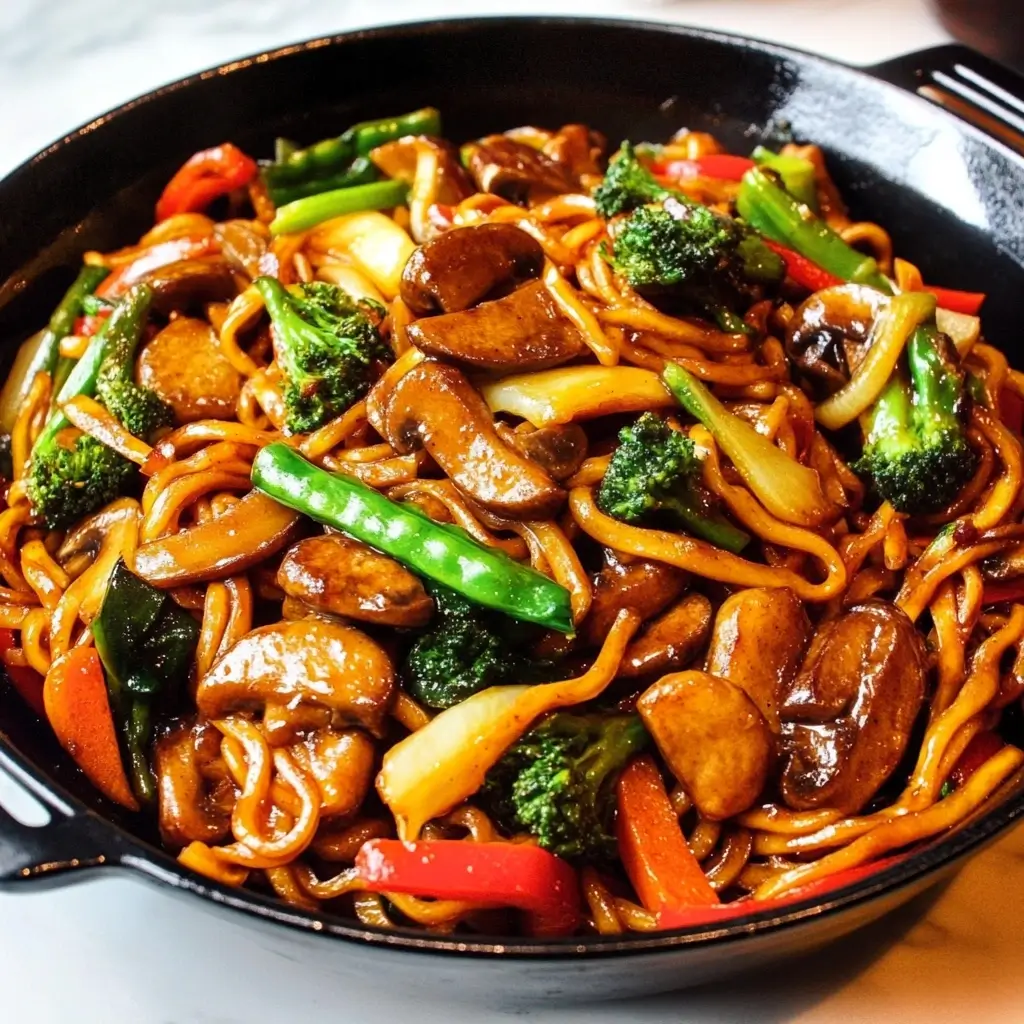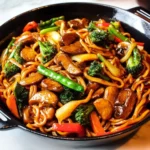There are some dishes that just feel like a warm hug, and for my family, this Simple Veggie Lo Mein is exactly that. It started as an attempt to recreate our favorite takeout dish on a busy weeknight, and honestly, I was skeptical if I could match that restaurant-quality flavor at home without a fiery wok burner and a pantry full of obscure ingredients. But to my utter delight, and more importantly, my family’s, this recipe was an instant hit! The kids, who can sometimes be picky about vegetables, were twirling noodles and munching on bell peppers and broccoli with genuine enthusiasm. My partner, a self-proclaimed noodle connoisseur, gave it two thumbs up, praising the savory sauce and the perfectly tender-crisp veggies. What I love most is its sheer versatility and speed. From chopping board to dinner table in under 30 minutes? Yes, please! It’s become our go-to for a quick, satisfying, and surprisingly healthy meal that leaves everyone feeling good. The aroma alone, as the ginger, garlic, and sesame oil hit the hot pan, is enough to make everyone gather in the kitchen, eagerly anticipating dinner. This isn’t just a recipe; it’s a weeknight win, a crowd-pleaser, and a testament to how simple, fresh ingredients can create something truly special.
Ingredients
Here’s what you’ll need to create this vibrant and flavorful Simple Veggie Lo Mein:
- Lo Mein Noodles (8 ounces / 225g): Fresh or dried egg noodles are traditional. If using dried, cook according to package directions. Fresh noodles often just need a quick blanch. Spaghetti or linguine can work in a pinch!
- Low-Sodium Soy Sauce (1/4 cup / 60ml): The backbone of our sauce, providing salty, umami depth. Low sodium helps control the saltiness.
- Toasted Sesame Oil (1 tablespoon): Adds a distinctive nutty aroma and flavor that is crucial for authentic Lo Mein. A little goes a long way!
- Oyster Sauce (2 tablespoons) (or Vegetarian Oyster Sauce): For a deep, savory, and slightly sweet flavor. Vegetarian versions made from mushrooms are excellent.
- Brown Sugar (1 teaspoon, packed): Balances the saltiness and adds a touch of sweetness. Maple syrup or honey can be substituted.
- Rice Vinegar (1 teaspoon): Adds a hint of acidity to brighten the sauce.
- Cornstarch (1 teaspoon): Mixed with a little water to create a slurry, this will help thicken the sauce slightly to coat the noodles beautifully.
- Neutral Cooking Oil (2 tablespoons): Such as canola, vegetable, or avocado oil, for stir-frying.
- Fresh Ginger (1 tablespoon, minced): Provides a warm, pungent spice. Fresh is best!
- Fresh Garlic (3 cloves, minced): Aromatic and essential for building flavor.
- Broccoli Florets (1 cup): Cut into small, bite-sized pieces for quick cooking.
- Carrots (1 large, julienned or thinly sliced): Adds sweetness, color, and a pleasant crunch.
- Bell Peppers (1 large, any color, thinly sliced): Red, yellow, or orange peppers add sweetness and vibrant color. Green adds a slightly more savory note.
- Snow Peas or Snap Peas (1 cup): Provide a lovely crunch and fresh green flavor. Trim the ends.
- Mushrooms (1 cup, sliced): Shiitake, cremini, or button mushrooms all work well, adding an earthy, meaty texture.
- Green Onions (2-3, sliced, greens and whites separated): Whites are sautéed for aroma; greens are used as a fresh garnish.
- Optional: Sriracha or chili garlic sauce (to taste): For those who like a little kick!
- Optional Garnish: Toasted Sesame Seeds: For a final flourish of nutty flavor and visual appeal.
Instructions
Follow these simple steps to Lo Mein perfection:
- Prepare the Noodles: Cook the Lo Mein noodles according to the package instructions. If using fresh noodles, they may only need a quick blanch in boiling water. Drain them well, rinse with cold water to stop the cooking process and prevent sticking, and toss with a teaspoon of sesame oil to keep them separated. Set aside. This step is crucial for ensuring your noodles don’t become a clumpy mess.
- Mix the Sauce: In a small bowl, whisk together the low-sodium soy sauce, toasted sesame oil, oyster sauce (or vegetarian alternative), brown sugar, and rice vinegar. In a separate tiny bowl, mix the cornstarch with 1 tablespoon of cold water to create a smooth slurry. Add this slurry to the sauce mixture and whisk again until well combined. Set aside. This sauce is the heart of the dish, so ensure it’s well-blended.
- Prep the Vegetables: Ensure all your vegetables are washed, chopped, and ready to go before you start stir-frying. Stir-frying is a quick process, so having everything “mise en place” (everything in its place) is key. This means broccoli florets are bite-sized, carrots are julienned or thinly sliced, bell peppers are sliced, snow peas are trimmed, mushrooms are sliced, and green onions are separated into whites and greens.
- Sauté Aromatics: Heat the neutral cooking oil in a large skillet, wok, or Dutch oven over medium-high heat. Once the oil is shimmering, add the minced ginger, minced garlic, and the white parts of the green onions. Stir-fry for about 30 seconds to 1 minute, until fragrant. Be careful not to burn the garlic, as this can make it bitter.
- Stir-fry Harder Vegetables: Add the broccoli florets and carrots to the skillet. Stir-fry for 3-4 minutes. These vegetables take a bit longer to cook, so they go in first. You want them to start to become tender-crisp.
- Add Softer Vegetables: Add the sliced bell peppers, snow peas (or snap peas), and mushrooms to the skillet. Continue to stir-fry for another 3-4 minutes, or until all the vegetables are tender-crisp. They should still have a bit of a bite and retain their vibrant color. Avoid overcooking, which can lead to mushy vegetables.
- Combine and Sauce: Add the cooked noodles to the skillet with the vegetables. Pour the prepared sauce mixture over everything. Toss gently but thoroughly using tongs or two large spoons to coat all the noodles and vegetables evenly with the sauce. Cook for another 1-2 minutes, allowing the sauce to thicken slightly and everything to heat through.
- Finish and Serve: Stir in the green parts of the green onions. Taste and adjust seasoning if necessary – you might want a dash more soy sauce or a touch of Sriracha for heat. Serve immediately, garnished with toasted sesame seeds if desired.
Nutrition Facts
- Servings: This recipe generously serves 4 people.
- Calories per serving: Approximately 380-450 kcal (This can vary based on the exact type and amount of noodles and vegetables used).
- Fiber (approx. 6-8g): High in dietary fiber from the abundance of vegetables, promoting digestive health and satiety.
- Vitamin C (High % DV): Packed with Vitamin C, especially from bell peppers and broccoli, supporting immune function.
- Protein (approx. 10-12g): Primarily from the noodles and vegetables; can be easily boosted by adding tofu, edamame, or other plant-based proteins.
- Sodium (Moderate): Using low-sodium soy sauce helps manage sodium levels, but be mindful if you are on a strict low-sodium diet.
- Low Saturated Fat: When using neutral cooking oil and lean ingredients, this dish is relatively low in unhealthy saturated fats.
Preparation Time
- Prep Time (Chopping & Sauce): Approximately 15-20 minutes. This involves washing and chopping all the vegetables, mincing the ginger and garlic, and whisking together the sauce. Efficient chopping can significantly reduce this time.
- Cook Time (Noodles & Stir-fry): Approximately 10-12 minutes. Cooking the noodles and stir-frying the vegetables and combining everything is a quick process.
- Total Time: Approximately 25-32 minutes. This makes it an ideal candidate for a quick weeknight dinner when you’re short on time but craving something delicious and satisfying.
How to Serve
This Simple Veggie Lo Mein is a fantastic standalone meal, but here are some ideas to elevate your serving experience:
- Classic Bowl:
- Serve generously in individual wide, shallow bowls. This allows for easy twirling of noodles and showcases the colorful vegetables.
- Family Style:
- Present the Lo Mein on a large platter in the center of the table, allowing everyone to serve themselves. This is great for gatherings.
- Garnishes Galore:
- Toasted Sesame Seeds: A sprinkle adds a nutty crunch and visual appeal.
- Freshly Sliced Green Onions (Greens): Adds a pop of fresh, mild onion flavor and color.
- Chopped Cilantro: If you enjoy cilantro, a handful adds a bright, herbaceous note.
- A Wedge of Lime: A squeeze of fresh lime juice can brighten up all the flavors.
- Chili Oil or Sriracha Drizzle: For those who like it spicy, a drizzle on top allows individuals to customize their heat level.
- Side Dish Pairings:
- Crispy Spring Rolls: Vegetarian spring rolls make an excellent crunchy accompaniment.
- Edamame: Steamed and lightly salted edamame pods are a healthy and simple side.
- Simple Cucumber Salad: A refreshing Asian-style cucumber salad with rice vinegar and sesame oil can balance the richness of the Lo Mein.
- Miso Soup: A light, savory miso soup can be a wonderful starter.
- Protein Boost (Optional):
- Serve alongside or mix in pan-fried or baked tofu cubes, tempeh, or a handful of roasted peanuts or cashews for added protein and texture.
- Chopsticks or Fork?:
- Offer both! While traditionally eaten with chopsticks, ensure forks are available for those who prefer them.
Additional Tips
Make your Simple Veggie Lo Mein even better with these handy tips:
- Don’t Overcook the Noodles: Cook noodles just until al dente (slightly firm to the bite). Rinse them with cold water immediately after draining to stop the cooking process and wash off excess starch, which helps prevent them from sticking together. Tossing with a little sesame oil also helps.
- High Heat is Your Friend: For stir-frying, use medium-high to high heat. This allows the vegetables to cook quickly, searing the outside while keeping them crisp on the inside, and helps to develop that characteristic “wok hei” (breath of the wok) flavor, even without a traditional wok.
- Don’t Crowd the Pan: If your skillet or wok isn’t large enough, cook the vegetables in batches. Overcrowding the pan will lower the temperature, causing the vegetables to steam rather than stir-fry, resulting in soggy veggies.
- Customize Your Veggies: This recipe is incredibly versatile. Feel free to swap in your favorite vegetables or use whatever you have on hand. Bok choy, zucchini, celery, bean sprouts, edamame, or even napa cabbage are all great additions. Just be mindful of their different cooking times.
- Sauce Consistency: If you prefer a thicker sauce, you can add a little more cornstarch slurry. If you want it thinner, a splash of water or vegetable broth will do the trick. Always taste and adjust the sauce seasonings before adding it to the noodles.
- Protein Power-Up: Easily make this a more substantial meal by adding plant-based proteins like cubed firm or extra-firm tofu (pan-fried or baked until golden), tempeh, seitan, or edamame. For non-vegetarians, shrimp, chicken, or beef strips work well. Cook the protein separately and add it in with the noodles.
- Prep Ahead for Speed: To make this dish even faster on a busy night, chop all your vegetables and mix the sauce ingredients (except the cornstarch slurry, which should be made just before use) a day in advance. Store them in airtight containers in the refrigerator.
- Fresh Aromatics are Key: While garlic powder and ginger powder can be used in a pinch, fresh minced garlic and ginger make a world of difference in the flavor profile of your Lo Mein. The vibrant, pungent notes they provide are irreplaceable.
FAQ Section
Q1: What’s the difference between Lo Mein and Chow Mein?
A1: The main difference lies in how the noodles are prepared. For Lo Mein (which means “tossed noodles”), cooked noodles are tossed with sauce, vegetables, and protein at the end of the cooking process. The noodles remain soft. For Chow Mein (“fried noodles”), the noodles are often fried until crispy or semi-crispy, and then the other ingredients are typically poured over them or lightly tossed. Our Simple Veggie Lo Mein features soft, saucy noodles.
Q2: Can I make this recipe gluten-free?
A2: Absolutely! Substitute the traditional egg noodles with gluten-free pasta (like rice noodles, gluten-free spaghetti, or specific gluten-free Lo Mein noodles). Also, ensure you use gluten-free soy sauce (tamari is a great option) and a gluten-free oyster sauce (or check your vegetarian oyster sauce label).
Q3: What are the best vegetables to use in Veggie Lo Mein?
A3: The beauty of Lo Mein is its versatility! Crunchy vegetables work best. Our recipe uses broccoli, carrots, bell peppers, snow peas, and mushrooms. Other great options include bok choy, cabbage (Napa or green), bean sprouts, zucchini, celery, water chestnuts, and bamboo shoots. Aim for a variety of colors and textures.
Q4: Can I prepare the Lo Mein sauce in advance?
A4: Yes, you can! Mix all the sauce ingredients (soy sauce, sesame oil, oyster sauce, brown sugar, rice vinegar) and store it in an airtight container in the refrigerator for up to 3-4 days. Whisk the cornstarch slurry in just before you’re ready to use the sauce.
Q5: How do I prevent my noodles from sticking together?
A5: After cooking and draining your noodles, immediately rinse them under cold water. This stops the cooking process and washes away excess starch. Then, toss them with a small amount of oil (sesame oil is great for flavor, or a neutral oil works too). This light coating will prevent clumping.
Q6: How should I store and reheat leftover Lo Mein?
A6: Store leftover Veggie Lo Mein in an airtight container in the refrigerator for up to 3-4 days. To reheat, you can microwave it in short intervals, stirring in between, until heated through. Alternatively, for best results, gently reheat it in a skillet over medium heat. You might need to add a splash of water or broth to loosen the noodles and sauce, as they can dry out a bit upon refrigeration.
Q7: Can I add protein to this Simple Veggie Lo Mein?
A7: Definitely! For a plant-based boost, add pan-fried or baked tofu cubes, tempeh crumbles, edamame, or roasted peanuts/cashews. If you eat meat, cooked chicken, shrimp, beef, or pork strips can be added. Cook your chosen protein separately and then toss it in with the noodles and vegetables at the end.
Q8: How can I make my Lo Mein spicy?
A8: There are several ways to add heat! You can add a teaspoon or more of Sriracha, chili garlic sauce, or gochujang (Korean chili paste) to the sauce mixture. Alternatively, add a pinch of red pepper flakes along with the garlic and ginger, or drizzle some chili oil over the finished dish. Adjust the amount to your preferred spice level.
Enjoy making and devouring your delicious, homemade Simple Veggie Lo Mein! It’s a dish that proves that quick and easy can also be incredibly flavorful and satisfying.






